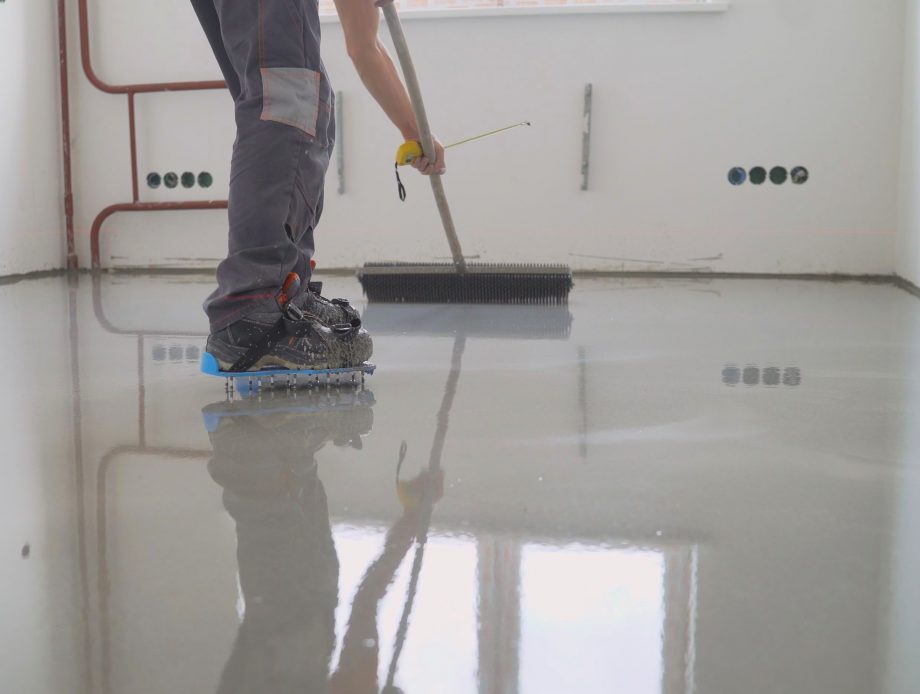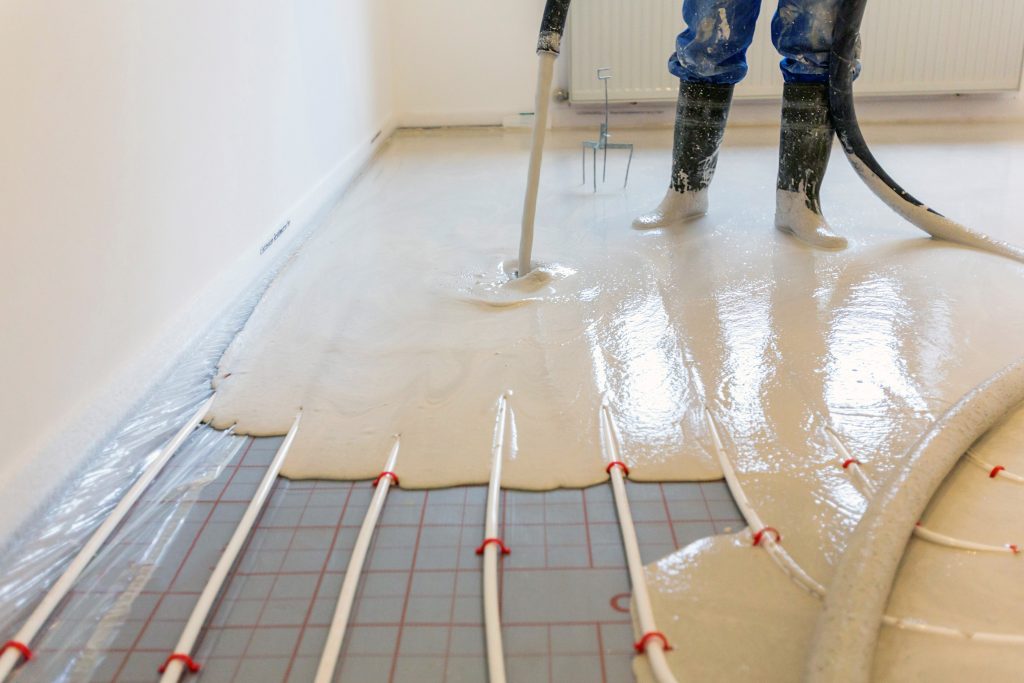If you are in a rush asking yourself how long before screed dries, look no further. In the below article we will discuss the main self-levelling floor screed questions our technical team are frequently asked. For example, we will answer how does screed dry, how long before you can paint new floors and when can you lay flooring on a new screed.

The Important Stuff: How Long Screed Takes To Dry Before Painting
Thankfully, there is a British Standard document to describe the proper processes for flooring screeds laid to receive further floorings. The document is ideal for screed contractors or users that intend on painting floors, and laying tiles or carpet after installation.
As you can imagine, the document is very detailed. The main point we would like to focus on in this article is just how long screed takes to dry. The code of practice suggests the following calculation for drying of screeds with no fast drying additive:
“With levelling screeds, one day should be allowed for each millimetre of thickness for the first 50 mm. This is followed by an increasing time for each millimetre above this thickness. It is therefore reasonable to expect a levelling screed 50 mm thick, drying under good conditions, to be sufficiently dry in about 2 months.”
For floor screeds between 50mm thickness and 75mm thickness, you should allow 2 days for drying for each millimetre of the screed’s thickness.
Therefore, a 75mm thick screed with no additive may expect to take 100 days to dry to 75% humidity. This is within good drying conditions.
However, in poor drying conditions when humidity is high and/ or temperature is low, drying may take considerably longer. This is especially true if moisture evaporating from screed and plaster is not extracted by open windows and doors or other means.
Promain’s Best Industrial Floor Screeds
Promain distribute a full range of industrial floor screeds. This includes both pre-packed screeds, additives and cement replacements:
- Mapei Ultraplan Renovation Screed 3240 – A fibre reinforced self levelling compound, for use in the refurbishment of existing floors.
- Centrecoat MMA Smooth Screed – A hard wearing, impervious floor finish. Full return to service in 2 hours. Hygienic, easy to clean and chemical resistant.
- Centrecoat MMA Fire Resistant Smooth Screed – A very fast curing fire-resistant and slip resistant screed offering a full return to service after just 2 hours.
- Rust-Oleum Speed Screed for Floors – A concrete repair for uneven, damaged or worn out concrete and power floated floors. For applications between 3mm to 15mm thick.
- Sika Sikafloor 81 EpoCem – A three part, epoxy modified cementitious, fine textured mortar. For self smoothing floor screeds in thin layers of 1.5 to 3mm.
- Mapei Ultratop Industrial – Self-levelling industrial floor screed based on special hydraulic binders. For abrasion-resistant flooring, with thicknesses from 5 to 40mm.
- Sika Sikafloor-122 Level Self Levelling Compound – a single part, ready to use, self leveller for floor smoothing. Levels uneven rigid internal floors prior to applying final wearing coverings.
How To Compare Different Screed Drying Times
When comparing specific drying claims made by manufacturers, it is advisable to look at the test drying conditions on the Product Data Sheets. Most manufacturers test after drying at a room temperature of 20°C. However, it depends on the manufacturer. For example, Mapei is based in Italy. Therefore, on Mapei datasheets the room temperature may be set to higher in warmer climates. Mapei datasheets usually set drying time figures to 23°C. Also, the air humidity set on the drying times with the data sheet is important. Tests carried out on samples cured at higher temperature and lower air humidity may produce apparently faster drying times.
It is important therefore to consider how close the curing conditions are to the reality of your own site conditions. For example, is it Winter? Is it the height of Summer? What is the humidity like at the moment? Always check the weather before commencing a job, even if you are indoors!
How Long Does Dry Screed Take To Dry
Before you jump in too quickly there are a number of key factors when asking how quickly flooring may be applied to a screed:
- Temperature in the room – lower temperatures will increase the drying time
- Humidity – The higher the air humidity in the room, the longer the drying time
- The mix of the screed – Always check the Product Data Sheet’s for full drying times
- Mixing equipment – Always check the Product Data Sheet for mixing instructions for tools
- The use of retarders or accelerators – These will increase or decrease the drying time of the screed.
- Increasing the aggregate/ cement ratio will also increase drying time.
- What are you laying on top of the screed? There may be different expectations on drying times for floors depending on final use. For example, whether you lay on top of it a paint, a 2 pack epoxy, wooden flooring, tiles or carpet.
Always ensure your new floor screed is sufficiently dry for application of further floorings. This is true whether you intend to use resilient floorings, carpet, quarry tiles, ceramic tiles or stone tiles. Drying time on site will vary according to site conditions. Increased screed thickness, lower temperature and higher humidity will lengthen the drying period.
How To Force Dry A Screed
It isn’t always possible to wait for a floor screed to dry naturally. However, screeds should be sufficiently dry and strong before you force dry floor screed. Beware – sometimes if you force dry, you increase the chance of the floor cracking. To force dry a screed, slowly raise the temperature marginally and increase the airflow. This can be by opening doors and windows. In colder months in may be beneficial to rent a dehumidifier. Dehumifiers work by extracting moisture from the air. This leads to more water from the floor being drawn into the air of the room. This water is then captured within the dehumidifiers drip tray.
When Can I Paint A New Screeded Floor?
If you are just looking for a floor sealer for new concrete floors there are faster options. For example, Sika Sikafloor ProSeal Pro works by curing, hardening and sealing fresh or hard concrete. Floor sealers such as this benefit from controlling dust. ProSeal Pro is suitable for new and existing concrete floor surfaces.
Please note though, we do not recommend painting a floor that already has a sealer on. You would need to remove the sealer before commencing a new paint system.
If however you are asking how long does it take for screed to dry out for painting, we suggest contacting our technical team. It really depends on the floor paint you intend to use. Generally it is 4 weeks, but do consult the screed manufacturer’s data sheet before jumping in.
Furthermore, Promain distribute Centrecoat Armourcoat WB 2-80. Contractors can apply this coating on 7 day old ‘green’ concrete. This is due to the paint’s breathable nature. Centrecoat Armourcoat WB 2-80 provides a tough, hard wearing protective floor finish to FeRFA standard 1 -2. This industrial floor paint is available in a range of colours, including clear.
Promain provide a full range of floor paints from leading manufacturers such as Sika, Remmers, Teamac, Centrecoat and Osmo. Take a look at these product categories below:
- Garage Floor Paint >>
- Resin Floor Coatings >>
- Wood Oils and Stains >>
- Electrostatic / Electro-Conductive Floor Systems >>
- Industrial Floor Paint >>
Our full floor paint category can be found here: https://www.promain.co.uk/floor-paints-and-coatings.html
When To Apply Wood Flooring On A New Screed
BS 8201:2011 Code of practice for installation of flooring of wood and wood-based panels refers to 75% screed humidity as being acceptable for installation of wood flooring. These figures are under dispute with many of the top wood flooring suppliers. Some say this figure should only apply to floating wood flooring. Various suppliers recommend a wide range of environment values they will accept. For example there is no consensus on lower screed surfaces, humidity figures or screed moisture content.
When Can I First Use Underfloor Heating Under A New Screed
Screeds should be sufficiently dry and strong before commissioning of underfloor heating commences. Otherwise, you risk damaging the screed and / or what is on top of the screed. This could be an expensive mistake if you have tiles or an industrial floor coating. In the case of carpet toppings, you may not even notice until too late when the damage is done.
At this stage, you will be able to turn your underfloor heating on. Ensure that you slowly increase the temperature in accordance with the instructions of the heating manufacturer. You should delay turning underfloor heating on for the first time at lower temperatures and when air humidity is high.
Promain are able to specify a range of floor screed systems for underfloor heating. We are proud UK distributors of Remmers and Sika flooring systems.

Conclusion
Did you enjoy reading this article? If you did take a look at these articles to further your knowledge on flooring:

